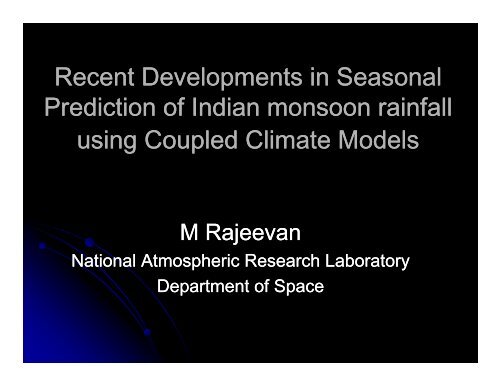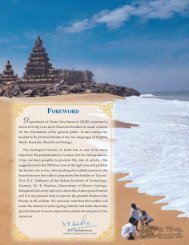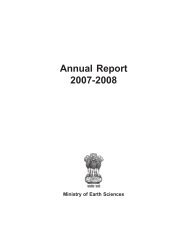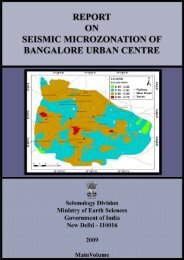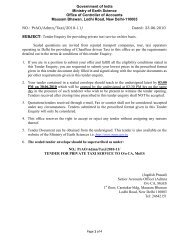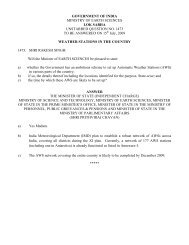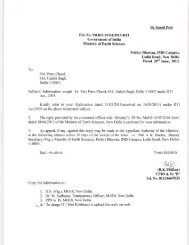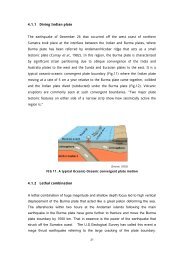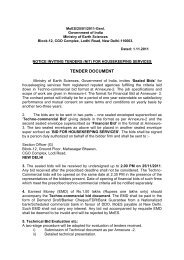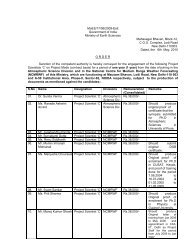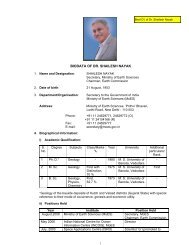Presentation of M Rajeevan
Presentation of M Rajeevan
Presentation of M Rajeevan
Create successful ePaper yourself
Turn your PDF publications into a flip-book with our unique Google optimized e-Paper software.
R Recent t Developments D l t i in S Seasonal l<br />
Prediction <strong>of</strong> Indian monsoon rainfall<br />
using Coupled Climate Models<br />
M <strong>Rajeevan</strong><br />
National Atmospheric Atmospheric Research Research Laboratory<br />
Laboratory<br />
Department <strong>of</strong> Space
Introduction<br />
IMD’s seasonal forecasts <strong>of</strong> Indian monsoon<br />
rainfall are mainly based on statistical models.<br />
Limited skill<br />
Limited scope<br />
Constraints due to epochal variation <strong>of</strong> predictor predictor- predictor<br />
rainfall relationships<br />
Limited understanding g <strong>of</strong> observed monsoon<br />
variability<br />
Users demand forecasts on higher g<br />
resolution
Introduction<br />
However, during the past 10 years, dynamical<br />
models (AGCMs) ( ) have been extensively y used<br />
for experimental seasonal forecasts.<br />
IMD Pune<br />
IITM Pune<br />
Pune<br />
IISc Bangalore<br />
CMMACS Bangalore<br />
SAC Ahmedabad<br />
CDAC Pune<br />
NAL Bangalore<br />
IIT Delhi<br />
NCEP coupled climate forecast system (CFS)<br />
IITM Pune running on operational basis<br />
CDAC Pune on experimental basis<br />
NCEP coupled climate forecast system (CFS)
Dynamical Models<br />
Evaluation <strong>of</strong> dynamical models is being<br />
done from the AMIP AMIP-1 1 era<br />
Gadgil and Sajini 1998<br />
Kang et et al. al. 2002<br />
2002<br />
Wang et al. 2004<br />
Seasonal prediction <strong>of</strong> Indian Monsoon<br />
(SPIM) project project- sponsored by Department <strong>of</strong><br />
Science Science and Technology<br />
Gadgil and Srinivasan (2010) Current Science<br />
5 AGCMs AGCMs, period: period: 1985 1985-2004 1985 2004
Dynamical Models<br />
Evaluation <strong>of</strong> coupled dynamical models<br />
Preethi ee e et a al. 2009 009 o on DEMETER results esu s<br />
Pattanaik and Kumar 2010, Yang et al.2008,<br />
Drbohlav et al 2010 on NCEP CFS<br />
<strong>Rajeevan</strong> and Nanjundiah 2010 on IPCC models<br />
Very modest results - AGCMs vs Coupled<br />
Models<br />
Not Not better than than statistical statistical models<br />
Stronger ENSO linkage, poor Indian Ocean<br />
li linkage<br />
k
EU EU- ENSEMBLES project p j<br />
The Development <strong>of</strong> a European Multi Multi-model model Ensemble<br />
System y for seasonal to inter inter-annual annual prediction p ( (DEMETER) )<br />
project (Palmer et al. 2004) provided an ideal opportunity to<br />
examine the simulation characteristics <strong>of</strong> the Indian summer<br />
monsoon.<br />
ENSEMBLE<br />
ENSEMBLE-based based predictions <strong>of</strong> climate changes and their<br />
impacts (ENSEMBLES) is an EU EU-funded funded integrated project<br />
th that t intends i t d t to develop d l an ensemble bl prediction di ti system t f for<br />
climate change based on the principal state state-<strong>of</strong> <strong>of</strong>-the the-art, art, high<br />
resolution global models developed in Europe.<br />
The project has been designated to produce for the first<br />
time, an objective probabilistic estimate <strong>of</strong> uncertainty in<br />
future climate climate at the seasonal to decadal and longer<br />
timescales
Dealing with forecast uncertainty<br />
● Model error is a major source <strong>of</strong> forecast uncertainty. Three<br />
approaches to deal with model error are being investigated in<br />
ENSEMBLES: multi multi-model, model model, stochastic physics and perturbed<br />
parameters.<br />
● The multi multi-model model is built from ECMWF, , Met Office, , Météo Météo-<br />
France operational activities and the DEMETER experience at<br />
IFM IFM-Kiel, Kiel, CERFACS and INGV.<br />
● Perturbed parameter system stems from the decadal<br />
prediction system (DePreSys) created at the Met Office.<br />
● Stochastic Stochastic physics ph sics s system stem uses ses the the ECMWF ECMWF stochastic<br />
stochastic<br />
backscatter system developed for medium medium-range range forecasts.<br />
● ~20 20,000 000 years years <strong>of</strong> <strong>of</strong> integrations.<br />
integrations
ENSEMBLE Models<br />
No models except the<br />
Depresys used the flux<br />
corrections.<br />
Depresys ensemble<br />
members are generated<br />
by perturbing<br />
parameters in the<br />
physical<br />
parameterization<br />
schemes.
ENSEMEBLES models<br />
Common hindcast period: 46 years (1960 (1960-2005) 2005)<br />
For For each each year year, 77-month<br />
7 month long long seasonal seasonal forecasts<br />
starting from 1 st February, May May, , August and<br />
November.<br />
9E 9 Ensemble bl M Members b<br />
Since DEMETER, the contributing seasonal<br />
prediction p systems y have improved p in all aspects p<br />
increase in resolution<br />
better representation <strong>of</strong> sub sub-grid grid physical processes<br />
land surface process process,<br />
sea sea-ice ice<br />
greenhouse gas boundary forcing<br />
more widespread use <strong>of</strong> assimilation for ocean<br />
initialization
Monsoon Seasonal Rainfall (June to September) in mm/day<br />
Observed ENSEMBLES Multimodel
Both DEMETER and<br />
ENSEMBLES predict more<br />
rainfall over the equatorial<br />
Indian Ocean compared to<br />
observations.
Biases in the Multi model monsoon rainfall
Mean rainfall<br />
(cm)<br />
Coefficient<br />
<strong>of</strong> Variation<br />
CV (%) ( )<br />
Observed 82.9 11.9 1.00<br />
ECMWF 93 93.2 2 45 4.5 037 0.37<br />
IFM-<br />
GEOMAR<br />
79.8 5.7 0.34<br />
METEO<br />
FRANCE<br />
45.0 8.2 0.34<br />
UKMO 80.0 12.2 0.39<br />
CMCC-<br />
INGV<br />
91.0 5.4 0.39<br />
DePreSys 65.6 8.9 0.27<br />
ENSEMBL<br />
ES MME<br />
DEMETER<br />
MME<br />
(1960-2001)<br />
75.8 5.7 0.45<br />
76.0 4.3 0.28<br />
Correlation<br />
Coefficient<br />
1960-2005
In comparison with DEMETER, ENSEMBLES results<br />
improved in drought g yyears<br />
like 1972, 1974 and 1979 and<br />
excess monsoon year like 1961.<br />
Problem remains for years like 1983 and 1997
In comparison with DEMETER, ENSEMBLES<br />
MME has better prediction skill. Each <strong>of</strong><br />
ENSEMBLES models except Depresys<br />
showed better skill than the DEMETER MME.
Probabilityy<br />
1.2<br />
1<br />
0.8<br />
0.6<br />
04 0.4<br />
0.2<br />
Probability forecasts <strong>of</strong> Indian Monsoon Rainfall<br />
Drought Excess<br />
Normal<br />
0<br />
1960 1963 1966 1969 1972 1975 1978 1981 1984 1987 1990 1993 1996 1999 2002 2005<br />
Year<br />
Positive skill for probabilistic forecasts <strong>of</strong> droughts<br />
BBrier i Skill SScore<br />
Drought: 00.201 201<br />
Excess : 0.060<br />
Normal= -0.002
ENSEMBLES predict<br />
an extended t d d warming i<br />
into central Pacific<br />
Ocean during g the<br />
1997 El Nino.<br />
Indian Ocean Dipole<br />
(IOD) signal is<br />
missing i i ffrom th the<br />
model predictions
ENSEMBLES predict<br />
an extended warming<br />
into central Pacific<br />
Ocean during 1983<br />
monsoon season.
Correlation between observed and model predicted rainfall
Monsoon Teleconnections
Monsoon Tele-<br />
connections<br />
ENSO-Indian<br />
monsoon<br />
teleconnection has<br />
weakened during<br />
the recent decades<br />
North Atlantic<br />
North Atlantic<br />
teleconnection has<br />
strengthened<br />
during the recent<br />
decades
Role <strong>of</strong> north Atlantic Ocean<br />
<strong>Rajeevan</strong> and Latha Sridhar, 2008,<br />
Geophys. Res. Letters
ENSEMBLES could<br />
not capture the<br />
recent weakening <strong>of</strong><br />
the ENSO-Indian<br />
ENSO Indian<br />
monsoon<br />
teleconnection.<br />
Correctly captures<br />
y p<br />
the north Atlantic<br />
teleconnection
ENSEMBLES could not capture the<br />
ENSEMBLES could not capture the<br />
recent weakening <strong>of</strong> the El Nino- Indian<br />
monsoon relationship
Prediction skill:<br />
1960-1979<br />
PPrediction di ti skill: kill<br />
1980-2005
Best <strong>of</strong> best IPCC models also showed excessive rainfall over<br />
the equatorial Indian Ocean.<br />
Rajee an and Nanj ndiah (2009) in “ C rrent Trends in<br />
<strong>Rajeevan</strong> and Nanjundiah (2009), in “ Current Trends in<br />
Science” Indian Academy <strong>of</strong> Sciences.
IPCC models showed colder SST bias<br />
over the Tropical Indian Ocean
Too stronger coupling <strong>of</strong> SST-rainfall in the<br />
IPCC coupled climate models<br />
<strong>Rajeevan</strong> and Nanjundiah (2009) in “ Current Trends<br />
<strong>Rajeevan</strong> and Nanjundiah (2009), in Current Trends<br />
in Science” Indian Academy <strong>of</strong> Sciences.
Observations ENSEMBLES<br />
Too stronger local air-sea coupling<br />
over the Indian ocean in the models
Observations ENSEMBLES
Observations ENSEMBLES
Scope for further improvement<br />
improvement<br />
Initialization <strong>of</strong> land surface conditions<br />
GHG forcing<br />
Stratospheric Processes
GHG effect in seasonal forecasts<br />
Constant GHG<br />
Correlation = 0.29<br />
Variable GHG<br />
Correlation = 0.68<br />
Francisco J Doblas-Reyes<br />
ECMWF<br />
WCRP workshop on seasonal<br />
Prediction Prediction, Barcelona Barcelona, 2007
Th Thank k you


